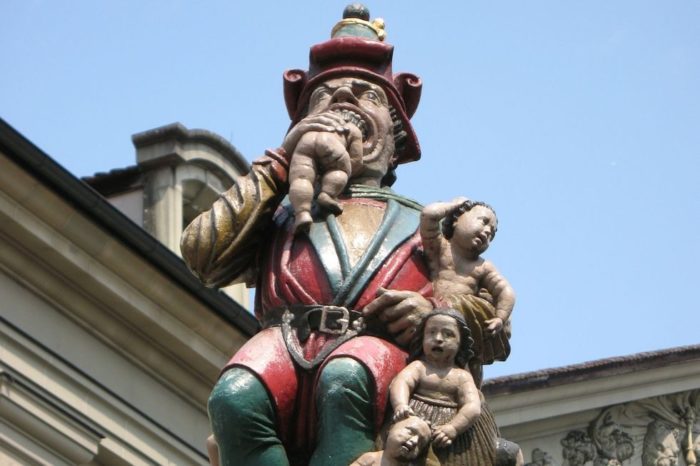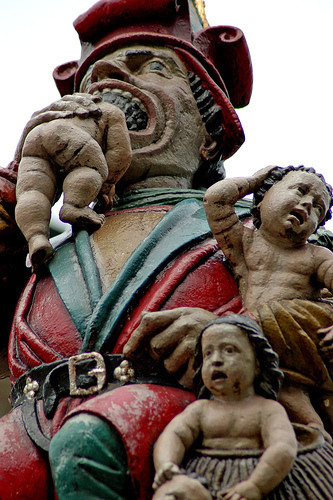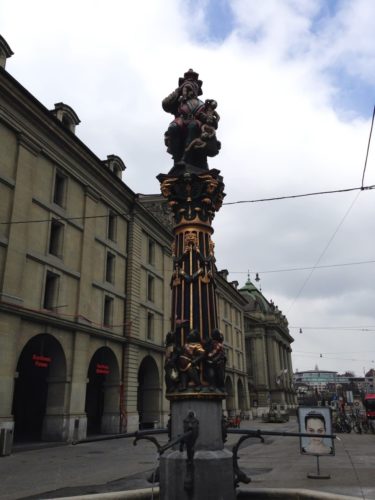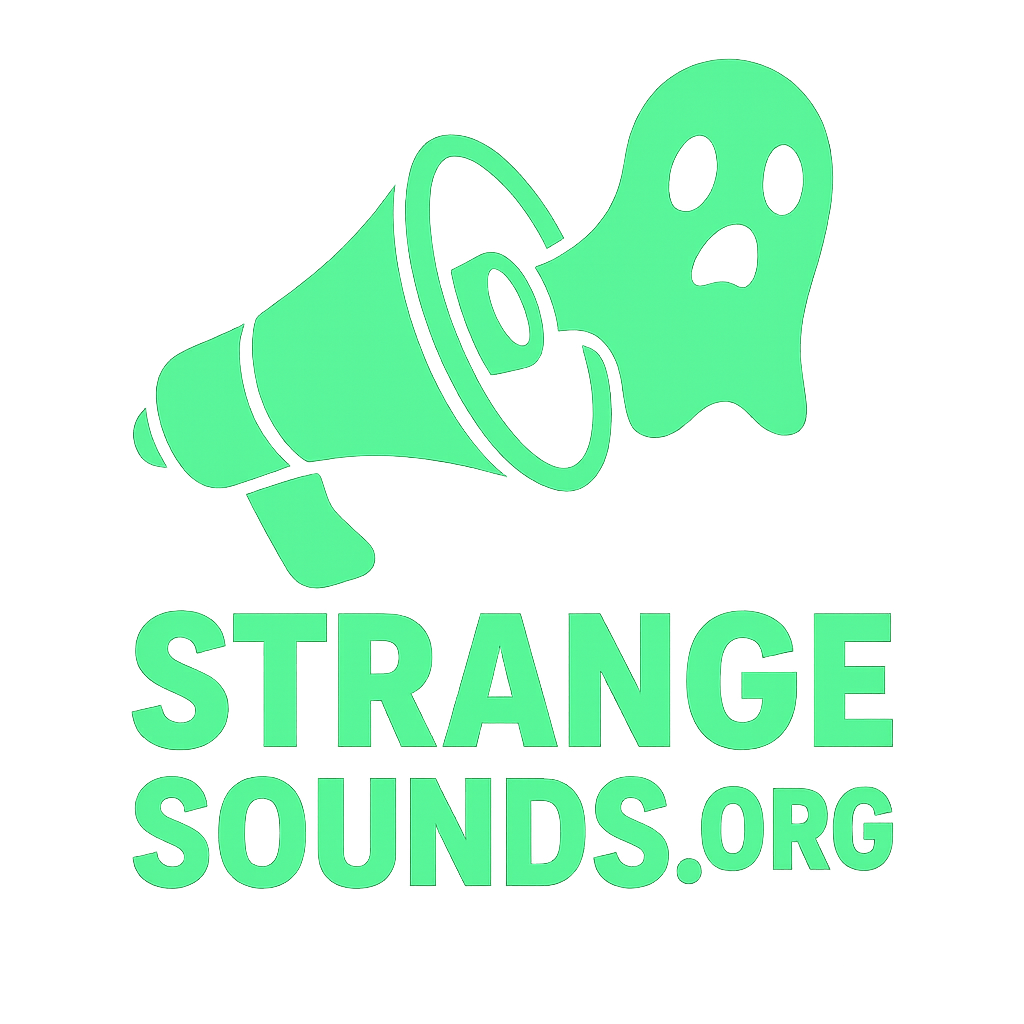Updated on: · 👉 Back to the Society & WTF Hub · 👉 Contact Strange Sounds
Summary: In the heart of Bern’s Old Town stands Kindlifresserbrunnen—the infamous “Child Eater” fountain (1546). The ogre bites a baby while more children spill from a sack. No one knows the true meaning, but four leading theories keep the legend alive.

Fast Facts
- What: Kindlifresserbrunnen (“Child Eater” fountain)
- Where: Kornhausplatz, Old Town, Bern, Switzerland (UNESCO site)
- When: 1546 (Renaissance city fountain)
- Why it’s famous: Gruesome ogre eating a child; meaning remains debated
- Best time to see: Daylight for details; evening for eerie vibes
A 16th-Century Mystery in the Middle of Bern
Bern’s Kindlifresserbrunnen is one of the city’s oldest and strangest fountains. The statue shows an ogre mid-bite with a baby in his mouth and a bag of children hanging from his shoulder. Though built in 1546, its original meaning was never recorded—leaving room for legends, fear, and (let’s be honest) unforgettable tourist photos.
What Does Kindlifresserbrunnen Mean? 4 Leading Theories
1) A Warning to a Minority Community (Contested)
Some historians once suggested the figure could be a hostile warning aimed at Bern’s Jewish community, citing the ogre’s pointed headgear resembling the Judenhut historically imposed on Jews in parts of medieval Europe. This interpretation is contested and sensitive; there is no definitive proof in city records. Treat this theory as part of a broader, difficult historical context rather than a confirmed origin.

2) The Greek Titan Kronos
Another view is that the statue echoes Kronos (Cronus), the Greek Titan who devoured his children to prevent their eventual revolt. The child-eating motif fits, though a direct design link from 16th-century Bern to the Kronos myth is unproven.
3) A Dark Local Legend About a Jealous Brother
Some say the ogre represents the older brother of Duke Berchtold (Bern’s legendary founder). Overshadowed and enraged, he supposedly turned on the town’s children. It’s a chilling tale—but no contemporary record supports it.

4) A Folkloric “Boogeyman” from Carnival Tradition
The most plausible explanation ties the ogre to Swiss Fastnacht (Carnival) and broader Alpine folktales. Parents warned kids to behave or the Kinderfresser (“child eater”) would come for them. Like many medieval public artworks, the statue may have doubled as a moral lesson—graphic enough that kids got the message.
War, Famine & Fear: Why the Image Stuck
During times of war and famine, Europe saw soaring fear and superstition. Grotesque imagery—ogres, demons, witches—served as stark public reminders about order, morality, and survival. Whether inspired by myth or local lore, the Child Eater likely resonated because it mirrored very real anxieties of the era.

How to See Kindlifresserbrunnen (Visiting Tips)
- Location: Kornhausplatz, Old Town Bern (short walk from Zytglogge clock tower).
- Cost: Free; outdoors, viewable 24/7.
- Photography: Morning light for sculptural details; evenings for dramatic mood.
- Nearby: Zytglogge, Bundesplatz, Münster Cathedral, Kindlifresser’s many calmer fountain cousins.
FAQ
Is the “Child Eater” real?
It’s a 16th-century statue, not a reference to a specific event. The gruesome scene is symbolic/folkloric.
Who carved it?
The fountain dates to 1546. Attribution varies in sources; it’s often linked to the circle of Renaissance sculptors active in Bern. The exact original commission note hasn’t survived publicly, which fuels the mystery.
Why is it so disturbing?
Medieval and Renaissance public art could be shockingly graphic—designed to instruct, warn, or moralize. The ogre’s bite made sure kids remembered the rules.
Is it okay for kids to see?
It’s part of Bern’s cultural heritage. Parents commonly frame it as a historical curiosity and folktale figure—scary, yes, but also a conversation starter about art, history, and myth.













Parents warned kids to behave or the Kinderfresser (“child eater”) would come for them.
Just like the Scottish “Black Douglas” will come for you.
I’ll bet America has aborted many millions more children than this Swiss guy ever thought about.
Jews,allegedly killing and eating christian children?
That baby eating Giant in Bern is a True part of Swiss Culture & is directly related to the Vatican City in Rome. Nuns who were
Impregnated by Catholic Bishops & other ranking “men of the Cloth”…had their babies taken away at birth, and escorted to Bern by
Swiss Vatican Gurdsmen, to be eaten by the Swiss monster depicted by the Statue.
Uahhhh! Interesting!!! Do you have any indication, books about this history? Could you please indicate to me! Best regards!
[…] in Bern, Switzerland is of a guy eating babies, and nobody really knows why it’s there. https://strangesounds.org/2014/11/kindlifresserbrunnen-the-terrifying-child-eater-of-bern-mystery.htm… via DuckDuckGo for […]
[…] Pied Piper was real and another “Kindlifresserbrunnen” in medieval Europe. We should be very afraid of Zionists of every […]